Bye, Bye, Benjy—Marvel Ends Dan Slott’s The Thing With Issue #8
By Jeb D.
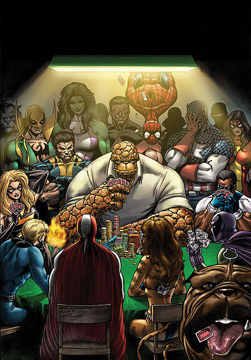 As we’ve known for some time now, the sales on this title have been lukewarm at best, and it barely had four issues out the door before Marvel announced its cancellation—not a move designed to bring new readers onboard. At a time when both DC and Marvel are proclaiming the tights and capes business healthier than it’s been in years, the sad truth is that getting the regular superhero readership behind a title that doesn’t feature Batman or Wolverine is harder and harder to do (fans of Manhunter know what I’m talking about). While I know that a lot of what gets tossed at the marketplace would never be missed, this is a good example of a quality series getting lost in the shuffle.
As we’ve known for some time now, the sales on this title have been lukewarm at best, and it barely had four issues out the door before Marvel announced its cancellation—not a move designed to bring new readers onboard. At a time when both DC and Marvel are proclaiming the tights and capes business healthier than it’s been in years, the sad truth is that getting the regular superhero readership behind a title that doesn’t feature Batman or Wolverine is harder and harder to do (fans of Manhunter know what I’m talking about). While I know that a lot of what gets tossed at the marketplace would never be missed, this is a good example of a quality series getting lost in the shuffle.
In this issue, as Slott promised, he brings us an event that I’m sure is unique in the history of superhero comics, and I don’t mean the big superhero poker game (which is fun, in and of itself). There’s guest stars galore (including Squirrel Girl!), a bit of a punchup with The Bi-Beast, and one of the FF’s craziest adversaries actually provides a nice turn for Ben Grimm’s love life, too.
Artist Kieron Dwyer has brought his A-game to this title, giving Ben Grimm as expressive a face as any artist to tackle the big guy, and he looks like he’s having a blast with all the guest stars. As I’ve mentioned before, though, this book (like a lot of current Marvel titles) is being inked too heavily, and colored too darkly, for its own good. There’s not a ton of action in this issue, which might hurt in the readership department, but you could say the same thing about some issues of New Avengers or Astonishing X-Men, which seem to sell just fine
There is a valedictory tone to it all, and I’m sure Slott already knew (or strongly suspected) that this would be the end as he was writing it. Plotlines get wrapped up, and Ben goes out with a hopeful grin. At the very least, the upcoming trade paperback is a reason for readers who haven’t tried the series yet to smile, too.
Marvel Editor in Chief Joe Quesada recently mentioned that Slott has pitched a new series idea that Marvel liked so much they’re going to go with it next year, despite their plan to launch fewer books in the future. That’s good news on two fronts: One, of course, that we get more Dan Slott. Two, and maybe more importantly, it suggests that someone in the Marvel bean-counting office has finally realized that their tactic of flooding retailers’ shelves as a way of holding onto market share is ultimately self-defeating. Readers know when a company is behind a book, and no one can put equal promotion behind everything. Fewer books, but books the company really believes in—seems like a fairly obvious notion, doesn’t it?
RATING: 
In the All New Atom, Size May Not Matter, But Writing Does
By
 Back when comics were a dime, a great cover was enough to entice someone to buy a book. A young fan could cut a few lawns in the neighborhood and buy every comic published that week. The covers in the three Showcase books and the first ten or so issues of his own title made The Atom a must buy kind of book at that time. Gil Kane’s pencils were great attractions even if his compositions were at that time fairly pedestrian. The solid storytelling kept the title and character alive for a number of years. However, lack of real imagination gradually killed a title that had great promise but inadequate follow through.
Back when comics were a dime, a great cover was enough to entice someone to buy a book. A young fan could cut a few lawns in the neighborhood and buy every comic published that week. The covers in the three Showcase books and the first ten or so issues of his own title made The Atom a must buy kind of book at that time. Gil Kane’s pencils were great attractions even if his compositions were at that time fairly pedestrian. The solid storytelling kept the title and character alive for a number of years. However, lack of real imagination gradually killed a title that had great promise but inadequate follow through.
In this new incarnation, which brings a sense of continuity to the character, a correspondent and admirer of Ray Palmer, The Atom of the 1960s, gains his Phd and the professorial chair he once held. Following clues from letters he received, Dr. Ryan Choi deciphers additional clues to bring himself to the brink of becoming the All New Atom. Unfortunately he isn’t all new. This origin story is unnecessarily complicated with a micro world parallel storyline and with writing that seems to contain non-sequiturs throughout.
Art is the sine qua non of comics, but writing makes or breaks a successful title. Some people love John Byrne’s artwork wherever it appears, but it is often undistinguished, with an air of sameness. This book is no different. The confused writing is no help. Yet the book is not without promise. If the micro world tie-in will just vanish, and the awe and wonder of the smallest portions of the world that actually do exist can be allowed to control the plots, this could become an excellent book. We get a taste of it, but the looming change of plot hangs like the sword of Damocles over its future. Byrne’s artwork is what it is. Those who love it will continue to do so. Those who feel differently will not be swayed by what they find here.
RATING: 
Take That, You Generic Evil Dictator—Image’s Task Force One Goes Into Action
By Jeb D.
 The idea of sending comic book superheroes into real-life (or at least realistic-seeming) armed conflicts isn’t a new one; among others, many of Marvel’s staple characters (Captain America, Human Torch, Sub-Mariner) got their starts fighting Hitler in World War 2. It’s been used occasionally over the years in series like Squadron Supreme and Watchmen, but it was the tremendous commercial success of Warrren Ellis and Bryan Hitch’s The Authority that practically made it a subgenre of its own. These days it’s such a staple that it’s more challenging for any such series to stand out from the rest.
The idea of sending comic book superheroes into real-life (or at least realistic-seeming) armed conflicts isn’t a new one; among others, many of Marvel’s staple characters (Captain America, Human Torch, Sub-Mariner) got their starts fighting Hitler in World War 2. It’s been used occasionally over the years in series like Squadron Supreme and Watchmen, but it was the tremendous commercial success of Warrren Ellis and Bryan Hitch’s The Authority that practically made it a subgenre of its own. These days it’s such a staple that it’s more challenging for any such series to stand out from the rest.
Image Comics’ latest stab at it is Task Force One, created by comics veteran Jim Valentino, scripted by newcomer Jeffrey Stevenson, and penciled by Shadowhawk veteran Carlos Rodriguez. It’s a tale about a group of government-engineered superheroes who may face greater peril from the degenerative quality of their powers than from any enemy they encounter. Valentino has cited the venerable 60’s THUNDER Agents book as an inspiration, while others have mentioned Marvel’s Strikeforce: Morituri as a predecessor, as well.
That’s certainly an interesting enough premise for a comic book. The chief problem with Task Force One is that, after I finished the first issue, I had to read a couple of interviews with Valentino to glean most of that. There’s promise here, but I fear Task Force One’s choppy storytelling falls a bit short in execution, so far.
The story opens with a splashy action scene that winds up with what might be one character’s superpowers destroying both him and his enemies. Then again, it might not—nothing leading up to that has suggested that this character has any powers, just that he’s the kind who plays chicken with very high stakes. Rodriguez paces this sequence nicely, though here (and later) he’s somewhat hampered by the fact that we really don’t know who anyone is yet: his strength is action, not well-distinguished faces, and there are times when it’s unclear whether a character on the page is someone we should know already. The choice of a slightly washed-out color palette (probably for a more “realistic” feel) doesn’t help with that.
We then cut to a government briefing that tells us about the disastrous failure of some super-secret Special Ops mission (involving the guy we saw blow up? I have no idea), and we’re going to meet the next step in that escalation: the government-sponsored superteam. Except that, after several re-readings, I’m still not entirely certain how many such teams there are (or were), and how much of the action I’m shown is taking place “now” and how much might be flashback to an earlier assignment. “Now”, by the way, is twenty years in the future, so we get a lot of fictitious names for countries and terrorist groups. While this frees the creative team from having to shoulder the specific burden of today’s political situation, it also causes much of the dialogue to revert to the generic.
The characterization is fairly by-the-numbers, with bantering insults and military-style jargon. You’ve seen this kind of bonding in plenty of cop shows and action movies. Unfortunately, once the team goes into action, you get the feeling that you’re supposed to know them well enough not to be surprised by some of what happens; as it is, though, a lot of it just comes out of left field. Stevenson and Rodriguez do give them a pretty spectacular battle scene, but it would help if we knew how and when that relates to other events in the book. At one point, I thought Rodriguez was employing some really poor perspective; again, a subsequent reading of Valentino makes clear that it was the depiction of a superpower.
There are some promising ideas at work here. I have the feeling that Task Force One will read much better in collected format, where some of the gaps that need filling in will likely be addressed. Honestly, though, while I will certainly read the next issue, with an eye toward another review, just as a reader, I’d be tempted not to bother. I wish I could give the book a strong endorsement in this format, but you might think about checking out the eventual trade collection to see if it lives up to its potential.
RATING: 
He is from Beyond! The Beyonder returns in BEYOND!#1
By Graig
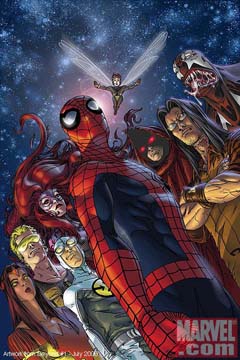 Growing up a DC lad, I completely missed out on Secret Wars and its sequel. As a comics geek I’m familiar enough with the stories of both to know that they’re not really essential reading, and compared to the crossovers that DC put out at that time, they pale when put to popular vote.
Growing up a DC lad, I completely missed out on Secret Wars and its sequel. As a comics geek I’m familiar enough with the stories of both to know that they’re not really essential reading, and compared to the crossovers that DC put out at that time, they pale when put to popular vote.
The six-issue Beyond! mini-series is, in essence, Secret Wars 3 (or, after finding out from Wikipedia that there was a Secret Wars 3 story that ran in the Fantastic Four, Secret Wars 4, if you will). The Beyonder has once again collected a group of Earth’s heroes and villains, bringing them aboard an interstellar spaceship/stadium to battle for their lives, the winner of the contest having their dreams granted as reality.
The contestants this go-around are hardly the cream of the crop, with the exception of Spider-Man. There’s Venom (who used to be Scorpion?), Kraven (the brother of the original?), the Wasp, Henry Pym, Medusa, The Hood (who?), Firebird, and Gravity, who acts as our P.O.V. character. When the offer by the Beyonder is made, it doesn’t take the villains very long to jump at the opportunity and get the contest rolling.
A prologue explains that the Secret Wars never actually stopped, that the Beyonder’s desire to observe good versus evil wasn’t satiated. An official gravedigger buries the fallen, and by the “Dear Tracy” narrative, I surmise it’s Deathlok, whom, it seems, got his wish to be Michael Collins again.
It’s good to see Dwayne McDuffie’s name on the cover of a comic book again. Though not for lack of trying, he’s been almost completely absent from the scene since the demise of the Milestone Media titles in the late 90’s. He’s done well for himself in animation, namely being the Producer and Story Editor for Justice League Unlimited, but it’s nice to see him back in the field. Beyond! #1 showcases McDuffie’s talent for snappy dialogue (something writers Robert Kirkman and Dan Slott have been getting a lot of praise for, but McDuffie’s been doing it for a lot longer), and his ability to take a mild concept and explore it in a different light. With artist Scott Kolins, McDuffie looks at the nature of violence, and man’s resistance to it, or, moreover, his predilection for it. The Beyonder, in this case, is the reader, or at the very least, the writer, taking these characters, giving them temptation and opportunity and seeing what happens. What could be just another fight comic (which sometimes isn’t a bad thing) or another attempt to legitimize a goofy concept (which arguably does sometimes work in the right hands) is given grit, heft and humour and it works.
RATING: 
![]()

The Life And Times Of Scrooge McDuck
(Gemstone Publishing)
By
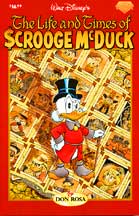 When one thinks of funny-animal comics, the mind instantly turns to the duck stories of Carl Barks. Originally employed in the animation department at Disney Studios, Barks was given the task of outlining a Donald Duck story that was being considered for a full length movie, titled Donald Duck Finds Pirate Gold but the project was set aside after Snow White and Pinocchio became wild hits, driving Disney toward pre-published material. The duck story later became a Dell Comics one-shot, drawn by Barks and another Disney artist, with considerable success. When Barks left Disney that same year, he was offered an opportunity to create his own Donald Duck ten page feature each month in Dell’s Walt Disney Comics and Stories, which had only used reprinted newspaper material to that point. His assignments grew. His stories appeared in most of the Disney titles under the Dell imprint, and his fan base grew despite the fact that Dell allowed no one to identify themselves as artist or writer. In 1947 he created Uncle Scrooge McDuck in a Donald Duck Book, Christmas On Bear Mountain, and fans were ecstatic. By 1952 Scrooge was given his own book.
When one thinks of funny-animal comics, the mind instantly turns to the duck stories of Carl Barks. Originally employed in the animation department at Disney Studios, Barks was given the task of outlining a Donald Duck story that was being considered for a full length movie, titled Donald Duck Finds Pirate Gold but the project was set aside after Snow White and Pinocchio became wild hits, driving Disney toward pre-published material. The duck story later became a Dell Comics one-shot, drawn by Barks and another Disney artist, with considerable success. When Barks left Disney that same year, he was offered an opportunity to create his own Donald Duck ten page feature each month in Dell’s Walt Disney Comics and Stories, which had only used reprinted newspaper material to that point. His assignments grew. His stories appeared in most of the Disney titles under the Dell imprint, and his fan base grew despite the fact that Dell allowed no one to identify themselves as artist or writer. In 1947 he created Uncle Scrooge McDuck in a Donald Duck Book, Christmas On Bear Mountain, and fans were ecstatic. By 1952 Scrooge was given his own book.
Scrooge’s stories are panoramic and epic. Taking place in every clime from Duckburg, his home, to the tops of the
In these books, Barks often alludes to Scrooge’s early life and the strife he endured to acquire his fortune. However he never gave us any direct retrospectives of the events. Don Rosa, in an amazing piece of scholarship, writing, and artwork, has pored over Barks’s stories for clues and given us a complete biography of Uncle Scrooge. So cannily written and illustrated,
RATING: 
The Eternals By Jack Kirby
(Marvel Publishing)
By Elgin Carver
 Jack Kirby is, without qualification, clearly the most influential comic book artist. He drew the first Captain Marvel Adventures issue. He created or co-created Captain America, Boy Commandos, Newsboy Legion, Fighting American, The Fly, Private Strong, The Fantastic Four, Thor, and has worked for practically every comic publisher that has ever existed. He was prolific to the point that it is difficult to imagine what the comics would be like, or even if they would exist at all, without him.
Jack Kirby is, without qualification, clearly the most influential comic book artist. He drew the first Captain Marvel Adventures issue. He created or co-created Captain America, Boy Commandos, Newsboy Legion, Fighting American, The Fly, Private Strong, The Fantastic Four, Thor, and has worked for practically every comic publisher that has ever existed. He was prolific to the point that it is difficult to imagine what the comics would be like, or even if they would exist at all, without him.
For those with long memories, Stan Lee, who deserves his share of the credit for the success of Marvel Comics and thereby the success of the modern comic industry, tried to take more than his share of the credit. In that dispute, Kirby found financial and artistic success at DC Comics for an extended period. When he and Lee reconciled, and upon his return to Marvel, one of his benefits was the ability to create works entirely his own. One such publishing event was The Eternals, a science fiction title that grew from the then popular concept that aliens had brought life to Earth and aided early civilizations to grow and flourish.
In this most Kirby-ish of all Kirby titles, gigantic armored aliens create three forms of life on earth. Humans, Eternals, and Deviants, the latter two hidden from our society. With this conceit, Kirby is able to tie all fables and legends from every culture into one mythic epic. In this hard bound compilation the original 19 issues plus the annual are reprinted in their entirety. Not a success in their day, they have aged relatively well. Kirby was a wonderful comic book artist but only an adequate comic book writer. Overly expansive in scope, the stories give a feeling of scale but no sense of a solid footing. Large enough to engage the imagination, the tales are too large to engage the mind. The value of this collection is that Kirby was clearly given free rein to follow his own muse. If you enjoy his work, you are unlikely to find a better single volume. Marvel has brought out a two volume Marvel Visionaries set. All such collections are printed on paper so bright as to distort the colors originally chosen to appear on paper with a non-glare finish and a slight tan color. In the Visionaries set the colors appear harsh. Here the subject matter allows the reader to accept this change. Few other complete collections of any title seems likely. Grab a copy while available.
RATING: 
Æon Flux tpb
(Dark Horse Comics)
By Graig Kent
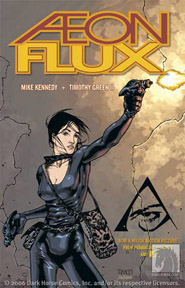 I was flipping through the Superman Returns “prequel” books the other day, you know the ones that explain what Ma Kent, Lex Luthor and Lois Lane were up to in the five years between Superman II and Bryan Singer’s new film, and my desire to pick them up waned with each flip of the page. The books, quite frankly, were ugly, and apparently took little care to try and reflect, at least visually, the world that Singer (or Richard Donner or, to a lesser degree, Richard Lester) crafted.
I was flipping through the Superman Returns “prequel” books the other day, you know the ones that explain what Ma Kent, Lex Luthor and Lois Lane were up to in the five years between Superman II and Bryan Singer’s new film, and my desire to pick them up waned with each flip of the page. The books, quite frankly, were ugly, and apparently took little care to try and reflect, at least visually, the world that Singer (or Richard Donner or, to a lesser degree, Richard Lester) crafted.
Now the Æon Flux movie is no Superman Returns – which is to say that the character holds none of the iconic status of Mr. Kent’s alter ego, nowhere near as much interest, and the difference in money sunk into each of them is probably represented by an additional “0” tacked onto the figure – but both were very sharp-looking, if a tad dull, films. Collecting the four-issue mini-series that acted as prequel to the Charlize Theron-led film, the Æon Flux trade paperback does well in capturing the design of the movie, with artist Timothy Green III infusing elements of Moebius and other European aesthetics into his work. If the movie succeeded anywhere it was in it’s visual flair – set design, costumes, lighting – and Green is not only able to emulate those elements, but also add his own sensibility to them. Even more, Green’s action sequences feel fluid and dynamic, the opening sequence of the book being the perfect bridge between the animated and celluloid world of Flux.
At this point I’ve read the prequel three times, and seen the movie once. While my desire to see the movie again is virtually nil, I really quite like this book. It has a Heavy Metal conceptual sci-fi vibe that lifts it above the movie it takes as source. Writer Mike Kennedy actually betters the film in characterization, plot, action and (especially) pacing, capturing some of the flavor of the MTV cartoon in the process. Though hardly a necessity given the movie’s success, Kennedy admirably worked the prequel seamlessly into the film’s lore. Fans of Theron’s Æon Flux, if there are any, will love this book. Those that wanted to like the movie but couldn’t will find comfort here.
RATING: 
Showcase Presents The Elongated Man
(DC Comics)
By Elgin Carver
 Jack Cole’s Plastic Man was a creation of genius. The only truly funny superhero comic, written and drawn successfully by Cole alone. The Elongated man is not Plastic Man, even if they both change shape. Mr. Fantastic of the Fantastic Four is a towering genius of the first water who has saved this planet more times than most heroes have stopped bank robbers. The Elongated Man is not Mr. Fantastic either, even if they both can stretch. In an almost unique position, Ralph Dibney, his secret identity, is a secondary character to both The Flash and Batman, yet not a sidekick. Often working on his own, he usually fights the ordinary criminal than the world conqueror. These stories from the late 1960s cast him more nearly as a superhero in the real world than any other in the DC stable.
Jack Cole’s Plastic Man was a creation of genius. The only truly funny superhero comic, written and drawn successfully by Cole alone. The Elongated man is not Plastic Man, even if they both change shape. Mr. Fantastic of the Fantastic Four is a towering genius of the first water who has saved this planet more times than most heroes have stopped bank robbers. The Elongated Man is not Mr. Fantastic either, even if they both can stretch. In an almost unique position, Ralph Dibney, his secret identity, is a secondary character to both The Flash and Batman, yet not a sidekick. Often working on his own, he usually fights the ordinary criminal than the world conqueror. These stories from the late 1960s cast him more nearly as a superhero in the real world than any other in the DC stable.
In this volume every cover and story is penciled by Carmine Infantino. Here he is at the top of his form. Slick compositions and stylish use of the page make his work the signature look of DC comics in the ’60s. The stories are written by either John Broome or Gardner Fox, both honed by decades of sweatshop production that taught them to churn out competent tales on a regular basis.
Most of the Showcase Presents titles have given us the secondary character titles and backup stories. We get over 500 pages of comics for less than the cost of most trade paperbacks. Like the other volumes, the presentation is in black and white on newsprint.These should be welcomed by every fan. Could they be improved? Certainly. Are you getting good value for the money? Without a doubt. This particular book was unexpected and a welcomed by is a very pleasant surprise to come out of the weekly box. Pull the hammock under the tree, get a cool beverage, and pass a pleasant summer day.
RATING: 
![]()

 The Goon #18 (Dark Horse) – Not only is this another heapin’ helpin’ of beautifully-rendered grossout silliness from Eric Powell, we get a slam-bang backup story nicely drawn by Mike Hawthorne, a Mike Allred pinup, and a fascinating note from Powell detailing the fate of the “suppressed” Goon story called “Satan’s Sodomy Baby,” as well as a hysterical running commentary from Frankie on just what we’re missing. Don’t miss The Goon, cuz if you do, he’s “comin’ up here with a pipe wrench and a mean disposition.” Consider yourself warned. –Jeb D.
The Goon #18 (Dark Horse) – Not only is this another heapin’ helpin’ of beautifully-rendered grossout silliness from Eric Powell, we get a slam-bang backup story nicely drawn by Mike Hawthorne, a Mike Allred pinup, and a fascinating note from Powell detailing the fate of the “suppressed” Goon story called “Satan’s Sodomy Baby,” as well as a hysterical running commentary from Frankie on just what we’re missing. Don’t miss The Goon, cuz if you do, he’s “comin’ up here with a pipe wrench and a mean disposition.” Consider yourself warned. –Jeb D.
RATING: 
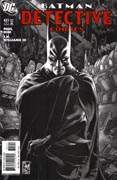 Detective Comics #821 (DC) – Paul Pope received a lot of fanfare for his lackluster “Batman: Year 100” – just as Frank Miller did for his similarly style-over-substance “DK 2.” So, why aren’t people lining up around the block when the real deal shows back up at Batman’s door? Paul Dini, arguably one of the best writers Batman has ever had because of his incredible work on “Batman: The Animated Series,” takes over “Detective Comics” for a six-month run of stand-alone mysteries starting with issue #821. That’s right – mysteries – the Dark Knight Detective doing what he does best, solving a crime. In the first issue – “The Beautiful People” – Dini successfully marries both sides of Batman’s detecting skill set: his ability to move easily in high places because of Bruce Wayne and his nocturnal Caped Crusader who takes the clues and puts a fist behind them. The villain? A beautifully drawn (by J.H. Williams III – bringing over some of the flair seen in “Desolation Jones”) masked criminal calling himself Façade. Dini is a great one for stand-alone Batman stories. He knows the characters, he knows how to tell an intricate story that doesn’t unnecessarily bloat out into six issues to sell a trade and he could obviously care less about the recent “Crisis,” concentrating instead on just doing great Batman. Can’t wait for next month. –Mark
Detective Comics #821 (DC) – Paul Pope received a lot of fanfare for his lackluster “Batman: Year 100” – just as Frank Miller did for his similarly style-over-substance “DK 2.” So, why aren’t people lining up around the block when the real deal shows back up at Batman’s door? Paul Dini, arguably one of the best writers Batman has ever had because of his incredible work on “Batman: The Animated Series,” takes over “Detective Comics” for a six-month run of stand-alone mysteries starting with issue #821. That’s right – mysteries – the Dark Knight Detective doing what he does best, solving a crime. In the first issue – “The Beautiful People” – Dini successfully marries both sides of Batman’s detecting skill set: his ability to move easily in high places because of Bruce Wayne and his nocturnal Caped Crusader who takes the clues and puts a fist behind them. The villain? A beautifully drawn (by J.H. Williams III – bringing over some of the flair seen in “Desolation Jones”) masked criminal calling himself Façade. Dini is a great one for stand-alone Batman stories. He knows the characters, he knows how to tell an intricate story that doesn’t unnecessarily bloat out into six issues to sell a trade and he could obviously care less about the recent “Crisis,” concentrating instead on just doing great Batman. Can’t wait for next month. –Mark
RATING: 
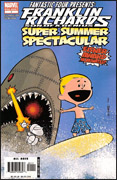 Franklin Richards: Son of a Genius Super Summer Spectacular (Marvel) – I’ve mentioned my ambivalence about this occasionally amusing series before, but in the wake of its Eisner Award nomination, this latest collection probably deserves coverage. Basically, this is a heavily Calvin and Hobbes-inspired humor comic featuring adventures of Reed and Sue Richards’ son. In a typical strip (usually 5 pages), Franklin hatches some scheme involving a futuristic gadget from his dad’s lab, and when things go haywire, he has to be rescued by his tutor/nursemaid H.E.R.B.I.E. (the little robot introduced for the Fantastic Four TV cartoon many years ago). Sometimes the stories are fun, and the artwork is charming, but even if you can get past the highly derivative nature of the strip, the repetition wears really fast in a collection of this type. I’m pleased that Marvel has revived the idea of the backup strip, and that’s really where Franklin Richards works the best: five pages at a time is about the proper dosage. – Jeb D.
Franklin Richards: Son of a Genius Super Summer Spectacular (Marvel) – I’ve mentioned my ambivalence about this occasionally amusing series before, but in the wake of its Eisner Award nomination, this latest collection probably deserves coverage. Basically, this is a heavily Calvin and Hobbes-inspired humor comic featuring adventures of Reed and Sue Richards’ son. In a typical strip (usually 5 pages), Franklin hatches some scheme involving a futuristic gadget from his dad’s lab, and when things go haywire, he has to be rescued by his tutor/nursemaid H.E.R.B.I.E. (the little robot introduced for the Fantastic Four TV cartoon many years ago). Sometimes the stories are fun, and the artwork is charming, but even if you can get past the highly derivative nature of the strip, the repetition wears really fast in a collection of this type. I’m pleased that Marvel has revived the idea of the backup strip, and that’s really where Franklin Richards works the best: five pages at a time is about the proper dosage. – Jeb D.